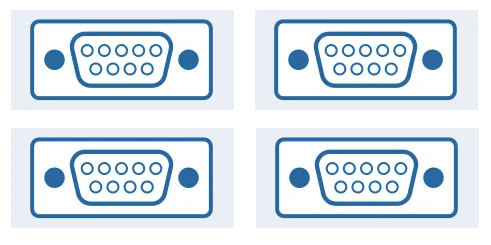Versatile Communications and I/O for Rugged Industrial Computers
October 20, 2023Rugged industrial computers are built to withstand and work in extreme conditions that either limit the functionality of normal consumer grade PCs or cause them to completely break down. There are many different strategies for ruggedizing industrial computers, but a factor nearly as important as the physical ruggedization is a robust and flexible mix of I/O. I/O is the critical link that enables devices to communicate with each other, allowing data to be passed between controllers, sensor systems, and rugged industrial computers. A trend driving Industry 4.0 has been the shift to retrofitting older machines and manufacturing processes with advanced electronics for remote monitoring and control. To facilitate this trend, companies are turning to engineers that specialize in I/O to design and develop smarter, more advanced I/ products that integrate embedded computing technology with the I/O required to interface with a vast assortment of sensors.
Rugged industrial computer systems need to manage a variety of data inputs that collect and send information for real-time decision-making. Therefore, modern industrial computers need to support a large variety of legacy and new I/O ports for more robust computing operations.
Serial Ports

Serial ports are among the most common legacy I/O connectors. While there are multiple different serial standards, the DE-9 is used in most serial connections. The primary limitation for the DE-9 port is the data rate, which, in the case of both Rs-422 and RS-485, has a maximum speed of around 10 Mbit/s.
RS-422
RS-422 uses two wires to send data between devices. One wire carries the data in a positive form and the other carries it in a negative form. The key functionality in RS-422 is “differential signaling.” This means that instead of measuring the voltage on a single wire – as in earlier serial connection ports – it looks at the difference in voltage between the two wires. This makes RS-422 connections less susceptible to electrical noise or interference, which allows the standard to employ a maximum cable length of 1200m.
RS-485
RS-485 expands on the functionality of RS-422. The RS-485 standard provides the ability to connect multiple devices in a daisy-chain or bus configuration. Each device has an address, and they take turns talking on the same wires. RS-485 can work in either half-duplex or full-duplex mode. In half-duplex, devices take turns sending and receiving data. In full-duplex, devices can send and receive data simultaneously.
USB

Over the past few decades, USB (Universal Serial Bus) has become the replacement for serial ports as users seek faster data rates. USB 3 data rates range from around 5 Gbit/s for USB 3.0 to 20 Gbit/s for USB 3.2. For a more detailed examination of USB specifications, read our white paper entitled, “Your Application: The Determining Factor for USB, CPU, and GPU Selection.” Essentially, as peripheral devices like sensors and cameras continue to increase in complexity, data rates much faster than those that can be achieved through serial ports are required.
While USB connections do indeed offer significantly faster data rates, there are a few other benefits. In addition to acting as a data transfer avenue, USB ports can also be used to power a device. This makes USB an excellent communication method for sensors and other small devices, as it can eliminate the need for a separate power cord. Further, while serial ports are, generally, a one-to-one port – with each separate device requiring its own serial port – USB can support up to 128 devices on a single port.
Wi-Fi

Wi-Fi in an industrial setting is very similar to any other Wi-Fi network. It allows various devices, machines, and sensors to connect to a network without using physical cables. Industrial Wi-Fi networks are set up with access points – analogous to Wi-Fi routers – throughout the target area to create a wireless network. Wi-Fi networks also offer incredibly flexible configuration options, allowing the customization of network performance and settings to best optimize connected systems. Wi-Fi enables the granular assignment of things like data rates, speeds, and limits, as well as access permissions per connected device. This flexibility allows for the creation of networks that are tailored to meet the most optimal settings for the connected devices.
CAN

CAN (Controller Area Network) is a serial communications protocol and bus standard, widely used in industrial and automotive applications. It’s designed to allow devices and sensors to communicate with each other reliably and efficiently. CAN was originally developed by Bosch in the mid to late 80s to connect all the sensors and electronic components in vehicles and allow them to exchange data and control signals.
CAN has a few major benefits. Firstly, implementing a CAN system is simple, and very low-cost. The device-to-device connections are made using a two-wire bus system, dramatically reducing the complexity of the system, and making it easy to add new devices to the network. Further, the simplicity of the system allows CAN the ability to provide real-time communications. Industrial processes often require precise timing and synchronization, and CAN is well-suited for tasks that demand quick and deterministic data transfer.
Deploying Versatile Communications with Sealevel
To future-proof your applications, rugged industrial computers must have a robust and flexible mix of I/O. Major technology advances in automation, IIoT, vision systems, and AI have led to a widespread shift toward retrofitting legacy machinery with advanced electronics. To interface with legacy machinery, it is vital for modern rugged industrial computers to include robust I/O configurations, including analog and digital connections, Wi-Fi, serial connectors, and USB connections that can support legacy technology.
Resources
Recent Articles
- Adapting to Changing Technology: USB to Serial
April 8, 2022 - It’s All About Intelligence
May 12, 2010 - The Top Three Reasons Linux is Running the World’s Supercomputers
September 13, 2022